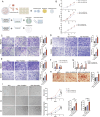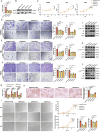Activating PIK3CA mutations in adipose-derived stem cells drive mutant-like phenotypes of wild-type cells in macrodactyly
- PMID: 40595500
- PMCID: PMC12217521
- DOI: 10.1038/s41419-025-07795-7
Activating PIK3CA mutations in adipose-derived stem cells drive mutant-like phenotypes of wild-type cells in macrodactyly
Abstract
Macrodactyly is a congenital overgrowth disorder characterized by pathological adipose proliferation due to PIK3CA mutations in adipose-derived stem cells (ADSCs). Due to the somatic mosaicism, the affected tissues comprise a mixture of mutant and wild-type cells. However, how PIK3CA mutated ADSCs influence adjacent wild-type cells in macrodactyly remains poorly understood. In this study, we utilized coculture systems to investigate the effects of macrodactylous adipose-derived stem cells (Mac-ADSCs) on normal ADSCs, fibroblasts (FBs), and vascular endothelial cells (VECs). Our study demonstrated that activating PIK3CA mutations in Mac-ADSCs promotes the proliferation, migration, invasion, adipogenesis, and angiogenesis of wild-type ADSCs, FBs and VECs. Furthermore, using RNA sequencing and cytokine arrays, we revealed that these effects are primarily mediated by various secreted paracrine cytokines. These findings demonstrated that activating PIK3CA mutation alters the paracrine characteristics of Mac-ADSCs and reshapes the microenvironment of macrodactyly, driving adjacent wild-type cells to exhibit mutant-like phenotypes. Targeting PIK3CA with BYL-719 could influence the progression of macrodactyly by inhibiting the paracrine signaling of Mac-ADSCs.
© 2025. The Author(s).
Conflict of interest statement
Competing interests: The authors declare no competing interests. Ethics approval and consent to participate: All methods were performed in accordance with the relevant guidelines and regulations. Ethical approval for this study was granted by the Institutional Review Board of Shanghai Ninth People’s Hospital (Approval Number: SH9H-2022-T357-1). Informed consent was obtained from all individual participants included in the study.
Figures






Similar articles
-
Activating PIK3CA mutation promotes adipogenesis of adipose-derived stem cells in macrodactyly via up-regulation of E2F1.Cell Death Dis. 2020 Jul 30;11(7):600. doi: 10.1038/s41419-020-02806-1. Cell Death Dis. 2020. PMID: 32732866 Free PMC article.
-
Activating PIK3CA mutation promotes osteogenesis of bone marrow mesenchymal stem cells in macrodactyly.Cell Death Dis. 2020 Jul 6;11(7):505. doi: 10.1038/s41419-020-2723-6. Cell Death Dis. 2020. PMID: 32632138 Free PMC article.
-
Long-term resident adipose-derived stromal stem cells in the microenvironment remodeling BLCA cell stemness and EMT promotes bladder cancer progression.Sci Rep. 2025 Jul 2;15(1):23049. doi: 10.1038/s41598-025-07387-7. Sci Rep. 2025. PMID: 40596589 Free PMC article.
-
The favorable impact of PIK3CA mutations on survival: an analysis of 2587 patients with breast cancer.Chin J Cancer. 2012 Jul;31(7):327-34. doi: 10.5732/cjc.012.10032. Epub 2012 May 24. Chin J Cancer. 2012. PMID: 22640628 Free PMC article.
-
Efficacy of adipose tissue-derived stem cells in locomotion recovery after spinal cord injury: a systematic review and meta-analysis on animal studies.Syst Rev. 2021 Jul 31;10(1):213. doi: 10.1186/s13643-021-01771-w. Syst Rev. 2021. PMID: 34330329 Free PMC article.
References
MeSH terms
Substances
Supplementary concepts
LinkOut - more resources
Full Text Sources
Medical
Miscellaneous

